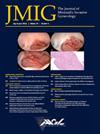Risk Factors and Prediction Nomogram of Local Regeneration After Ultrasound-Guided Microwave Ablation of Uterine Fibroids
IF 3.5
2区 医学
Q1 OBSTETRICS & GYNECOLOGY
引用次数: 0
Abstract
Study Objective
To explore the risk factors associated with local regeneration of the treated uterine fibroids (UFs) after microwave ablation (MWA) and to develop a nomogram model for predicting the risk of local regeneration.
Design
Retrospective study.
Setting
The Eighth Affiliated Hospital of Sun Yat-Sen University.
Patients
Patients with UFs who underwent MWA at our hospital between October 2020 and April 2023 were included.
Intervention
MWA was used for the treatment of UFs.
Measurements and Main Results
A total of 47 patients with 68 fibroids were included into this study. Over a median follow-up of 13 months (interquartile range, 8–22 months), local regeneration occurred in 11 UFs. The clinical and imaging characteristics of these patients were recorded and compared. Risk factors for local regeneration were determined through univariate and multivariate Cox regression analysis. Multivariate analysis revealed that the fertility desires, larger size of UFs (≥95.3 cm3), and hyperenhancement of UFs on contrast-enhanced ultrasound were independent risk factors for local regeneration after MWA. A predictive nomogram was constructed to predict the local regeneration after MWA of UFs. The concordance index (C-index) (C-index, 0.924; internal validation C-index, 0.895) and the 1- and 2-year area under the curve values (0.962, 0.927) all indicated that the nomogram had good predictive performance. Calibration and decision curve analysis curves further confirmed the model's accuracy and clinical utility.
Conclusion
Fertility desires, larger size of UFs, and hyperenhancement on contrast-enhanced ultrasound were independent predictors of UFs local regeneration after MWA in our study. The nomogram constructed based on the abovementioned independent risk factors may help predict which UFs will develop local regeneration after MWA.
超声引导下子宫肌瘤微波消融术后局部再生的风险因素和预测提名图。
研究目的探讨微波消融术(MWA)后子宫肌瘤(UFs)局部再生的相关风险因素,并建立预测局部再生风险的提名图模型:设计:回顾性研究:背景:中山大学附属第八医院:纳入2020年10月至2023年4月期间在我院接受MWA治疗的UFs患者:测量和主要结果:本研究共纳入47例68个子宫肌瘤患者。在中位 13 个月的随访期间(四分位间范围:8 至 22 个月),11 例 UFs 发生了局部再生。研究人员记录并比较了这些患者的临床和影像学特征。通过单变量和多变量 Cox 回归分析确定了局部再生的风险因素。多变量分析显示,生育愿望、UFs较大(≥95.3cm3)和对比增强超声(CEUS)显示的UFs高增强是MWA后局部再生的独立危险因素。为预测 UFs 在 MWA 后的局部再生情况,构建了一个预测提名图。一致性指数(C-index = 0.924,内部验证 C-index=0.895)以及 1 年和 2 年的曲线下面积(AUC)值(0.962,0.927)均表明提名图具有良好的预测性能。校准和决策曲线分析(DCA)曲线进一步证实了该模型的准确性和临床实用性:结论:在我们的研究中,生育愿望、UFs较大和CEUS高增强是MWA后UFs局部再生的独立预测因素。根据上述独立风险因素构建的提名图可能有助于预测哪些 UF 在 MWA 后会发生局部再生。
本文章由计算机程序翻译,如有差异,请以英文原文为准。
求助全文
约1分钟内获得全文
求助全文
来源期刊
CiteScore
5.00
自引率
7.30%
发文量
272
审稿时长
37 days
期刊介绍:
The Journal of Minimally Invasive Gynecology, formerly titled The Journal of the American Association of Gynecologic Laparoscopists, is an international clinical forum for the exchange and dissemination of ideas, findings and techniques relevant to gynecologic endoscopy and other minimally invasive procedures. The Journal, which presents research, clinical opinions and case reports from the brightest minds in gynecologic surgery, is an authoritative source informing practicing physicians of the latest, cutting-edge developments occurring in this emerging field.

 求助内容:
求助内容: 应助结果提醒方式:
应助结果提醒方式:


